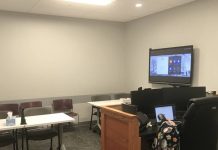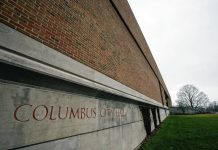It can be tough for new friends and co-workers to understand a Columbus man’s fascination with astronomy imaging.
But by drawing a parallel with the more widely recognized appeal of motorcycles, Joe Maschino is often able to make others better appreciate his 17-year passion.
Others seem to easily understand when he points out that no serious biker is content just looking at a picture of a popular motorcycle such as the Harley-Davidson Screamin’ Eagle.
That’s because they want to experience the ride themselves, he said.
[sc:text-divider text-divider-title=”Story continues below gallery” ]
Likewise, the 31-year-old Maschino isn’t satisfied just looking at a published photo from the Hubble telescope. It’s the experience of creating his own personal portraits of the universe — along with his own stories of discovery — that makes the experience special, he said.
Not everybody gets it, but Maschino said most people display a genuine fascination while he shows his many images of planets, stars, nebulae and galaxies.
“I often hear people say: ‘I didn’t know stars were that cool’,” the Columbus resident said.
While Maschino insists his portraits of the universe are not good enough for widespread distribution, his wife adamantly disagrees.
“I think they are much better than he thinks they are,” Christy Maschino said. “Eventually he should start submitting them to magazines.”
Back in 1999, it was observatory-quality photos published in a magazine that first inspired Maschino to wonder how such images are created, he said.
One year later, at age 15, he spent $400 earned from working on a farm to purchase his first telescope, utilizing books and constellation charts to take his first steps into exploring the universe, he said.
“Through the years, I kept adding little pieces and trinkets until I got what I have now,” said Maschino, who uses a sophisticated two-telescope system and computerized image-capturing equipment.
Building a lifelong hobby
His father said he recalls how frustrated his son was when he wasn’t allowed in his high school astronomy club due to his struggles with senior math.However, by using mathematics son Joe pulled from a magazine, he was able to build his own telescopes, David Maschino said.“It just goes to show what you can do when you set your mind to it,” his father said. “He’s constantly learning, and it fascinates me.”
Due to the constant rotation of the Earth, Joe Maschino relies on his software and automated telescope mount to both find the exact location he’s seeking and then track the object to ensure image clarity, he said.
“I used to have to hunt objects,” Maschino said. “Now, I just plug in whatever I want to look at, push a few buttons, and it goes there for me.”
While that sounds simple enough, there are still a number of inconveniences — and even a few heartbreaks, the amateur astronomer said.
For example, every photo requires up to a 5-minute exposure, and each completed image consists of up to six photos of the same object stacked on top of one another, Maschino said.
When you add the time it takes driving to a location, setting up the equipment, imaging, packing up the gear, and returning home, there is normally a four- to five-hour investment just to produce one image, he said.
And when Maschino finally gets back home, additional time is required to utilize software that cleans up light pollution and sharpens image quality, he said.
While all his gear fits neatly into a large trunk with wheels, the total weight is about the same as an empty refrigerator, making the act of load-up his vehicle a strenuous exercise, Maschino said.
Best opportunities
Star-gazing excursions usually are limited to the four or five days that lead up to a new moon or blue moon, which refers to the once-a-month phase when the moon does not appear to be illuminated by the sun.With such a short window of opportunity, a well-conceived play is easily ruined by overcast skies and precipitation — both of which are frustratingly common in south central Indiana, he said.But when nature does cooperate, he will head out to his father’s rural home, located off State Road 46 near the Bartholomew-Brown County line, to view the western skies.
For eastern star-gazing, his preferred location is Petersville Park, located off County Road 550E, just north of East 25th Street.
In both cases, the objective is to get as far away as possible from the light pollution of Columbus.
Being in Petersville Park after midnight can present its own challenges, such as when a police officer nearly blinded him by shooting a patrol car spotlight directly into his telescope as he looked through an eyepiece, Maschino said.
While talking with the officer, both men acknowledged that people attracted to rural parks in the wee hours of the morning are usually interested in something other than astronomy, Maschino said.
But the officer later agreed that Maschino may unintentionally serve as an crime deterrent because his nocturnal presence scares others off, he said.
“I know they don’t like me being there because they often squeal their tires while leaving to let me know,” Maschino said.
While his wife enjoys helping him process the completed images, staying up all night outside in the cold and dark “just isn’t her thing,” he said.
Christy Maschino agrees, adding her job with the Bartholomew Consolidated School Corp., their children’s extra-curricular activities and other responsibilities keep her well-occupied.
Although daughters Elise, 12, and Kaylee, 11, are slowly becoming intrigued with their father’s hobby, both are still too young to have the patience for astronomy, Joe Maschino said.
However, he has taken his girls to what’s called star parties, which are multi-day gatherings of amateur astronomers held to create camaraderie.
These events, which also expand skills and knowledge, were held last year near Frankfort in Clinton County and Pennyrile Forest State Resort Park in southwest Kentucky.
Aesthetics over science
Those who discuss astronomy with Maschino need not worry about getting an earful of complex scientific terms. He’s far more interested in the aesthetics than the science, he said.Furthermore, his hobby has not changed the fundamental religious convictions of his life-long Catholic faith, the Columbus resident said.But that doesn’t mean Maschino doesn’t contemplate philosophical aspects — such as the fact that the Andromeda Galaxy is 68 million light years from Earth.
“It’s so neat when I realize dinosaurs were on Earth when that light I’m looking at left its origin to get here,” Maschino said. “I also believe the galaxy is just too massive not to contain other intelligent life.”
But what really stands out in Joe Maschino’s mind is how comparatively microscopic and insignificant human beings are when compared with the vastness of the universe, he said.
“That makes me think that if I don’t do anything constructive, what’s the purpose of my life?” Maschino said. “So I try to accomplish things to make my existence worthwhile.”
[sc:pullout-title pullout-title=”Joe Maschino” ][sc:pullout-text-begin]
Joe Maschino
Age: 31
Residence: Flintwood Addition
Occupation: Construction
Education: Graduated from Columbus North High School in 2002
Family: Wife, Christy, a teaching assistant. Two daughters: Elise, 12, and Kaylee, 11.
[sc:pullout-text-end][sc:pullout-title pullout-title=”Hobby investment” ][sc:pullout-text-begin]
Joe Maschino estimates he has invested nearly $6,000 in his amateur astonomy equipment that includes:
- An 8-inch F4 Neutonian Astrograph Reflecting Telescope for imaging.
- A 80 mm Appochromatic Refractor for guiding.
- Two recently obtained eyepieces purchased for about $1,500.
- A laptop Dell computer with specialized software created for amateur astronomers.
- A computer-automated mount weighing about 40 pounds.
- A Canon Eos Rebel digital single lens reflective (DSLR) camera.
Maschino’s next anticipated investment will be a astronomical specified charged-coupled device (CCD) camera, capable of capturing more objects and provide better image clarity. According to online sources, a CCD camera can cost $600 to $2,500.
While admitting amateur astronomy can be expensive, his wife, Christy Maschino, says her husband only invests in his hobby when the couple has sufficient expendable income — and only when there is mutual consent to the purchase.
[sc:pullout-text-end]




